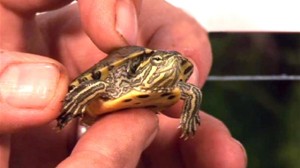We describe two cases of infant botulism due to Clostridium butyricum producing botulinum type E neurotoxin (BoNT/E) and a previously unreported environmental source.
 The infants presented at age 11 days with poor feeding and lethargy, hypotonia, dilated pupils and absent reflexes. Fecal samples were positive for C. butyricum BoNT/E. The infants recovered after treatment including botulism immune globulin intravenous (BIG-IV).
The infants presented at age 11 days with poor feeding and lethargy, hypotonia, dilated pupils and absent reflexes. Fecal samples were positive for C. butyricum BoNT/E. The infants recovered after treatment including botulism immune globulin intravenous (BIG-IV).
C. butyricum BoNT/E was isolated from water from tanks housing pet ‘yellow-bellied’ terrapins (Trachemys scripta scripta): in case A the terrapins were in the infant’s home; in case B a relative fed the terrapin prior to holding and feeding the infant when both visited another relative. C. butyricum isolates from the infants and the respective terrapin tank waters were indistinguishable by molecular typing. Review of a case of C. butyricum BoNT/E botulism in the UK found that there was a pet terrapin where the infant was living.
It is concluded that the C. butyricum-producing BoNT type E in these cases of infant botulism most likely originated from pet terrapins. These findings reinforce public health advice that reptiles, including terrapins, are not suitable pets for children aged <5 years, and highlight the importance of hand washing after handling these pets.
Infant botulism due to C. butyricum type E toxin: a novel environmental association with pet terrapins
Epidemiology and Infection / Volume 143 / Issue 03 / February 2015, pp 461-469
E.B. Shelley, D. O’Rourke, K. Grant, E. McArdle, L. Capra, A. Clarke, E. McNamara, R. Cunney, P. McKeown, C.F.L. Amar, C. Cosgrove, M. Fitzgerald, P. Harrington, P. Garvey, F. Grainger, J. Griffin, B.J. Lynch, G. McGrane, J. Murphy, N. Ni Shuibhne and J. Prosser
